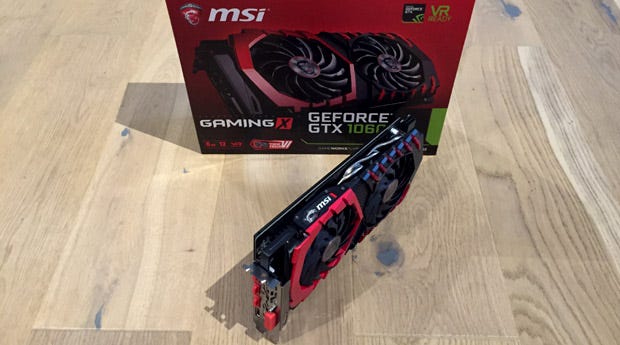Nvidia GeForce GTX 1060 review: The best 1440p graphics card (for now)
Is mid-range the new high end?
The Nvidia GeForce GTX 1060 is Nvidia's new mid-range contender, chasing the coat tails of its more powerful big brother, the Nvidia GeForce GTX 1070 and rubbing shoulders with the AMD Radeon RX 580 for 2560x1440 gaming goodness. Or at least the 6GB version of Nvidia's card is, as you'll also find lesser 3GB variants on sale as well.
3GB models have the same basic DNA as 6GB GTX 1060s, but they have slightly lower clock speeds and fewer cores, meaning performance won't be as good as their 6GB counterparts. Indeed, we wouldn't really recommend the 3GB GTX 1060, if only in the name of future-proofing yourself against the ever increasing memory requirements of the latest games. As you can see from our guide to the best graphics cards, you should really be looking at the 6GB version if you want something to rival the GTX 1070 at resolutions beyond 1080p, as there are plenty of cheaper cards, namely the Nvidia GeForce GTX 1050Ti, that do 1080p just as well as the 3GB GTX 1060 without you having to spend almost £300 for the privilege. Fortunately, we have one such 6GB card on test to show us what it's capable of. Say hello to the MSI GeForce GTX 1060 6GB Gaming X.
When it first came out, this particular card was quite pricey compared to other versions out there, but thanks to today's great GPU crisis, most retailers have leveled their GTX 1060 stock prices down to the same level - in this case, around £380 or $600. What makes this particular version special is that you get an extra 100 MHz on top of its base clock speed, plus a maximum boost clock speed of 1,809MHz. If that doesn't sound like much, it isn't. However, cards like this are arguably more about the potential for tweaking thanks to features like high-quality custom cooling and software tools than the modest bump.
To kicks things off, we booted up Doom. Courtesy of the new Vulkan patch, I can confirm that Doom absolutely flies on this board. At 2560x1440 with the details and options pretty much maxed out, it feels slick and quick. Is there a whiff of lag? Maybe, but it's there at 1080p, too, so I'll put that down to the game engine. What's really surprising is how playable Doom is at 4K. I had not been expecting that. OK, it's not as oily smooth and response as it is at lower resolutions and in truth you'd avoid 4K for multiplayer gaming. But as a showcase of what this ostensibly modest GPU can do, it's an eyebrow curler, for sure.
Next up is The Witcher 3, a game that caused the top-end Nvidia GeForce GTX 1080 to come a little unstuck, as it happens. Running at 2560x1440, initial impressions are good. Crikey, could this thing really be playable? Yes and no. Those teensy micro stutters that detract just marginally from the immersion are a little too frequent. The initial euphoria fades, if I'm honest, and over time the lack of top flight smoothness wears you down. Again, as is often the case, it's the step down to a lower resolution that really highlights the GTX 1060's small but significant shortcomings at 2560x1440.
As for 4K, well, it'll run – at a guess, I'd say it's delivering frame rates in the high teens - and you could probably make it fairly playable by tweaking the options. But real 4K performance is basically beyond this card, which is no surprise whatsoever.
On, then, to Total War: Attila. Here the litmus 2560x1440 resolution once again makes a good initial impression with smooth frame rates and decent response rates to inputs. But as with the GTX 1080, it's zooming right into dense troop formations that uncovers performance limitations. Knock the resolution down to 1080p and you'll discover just how fluid the troop animations can be.
Our final destination is the dreaded Shadow of Mordor. It's not a hugely demanding game, so no surprise to find it really very playable at 2560x1440. Again, it's that little bit smoother at 1080p, but you could happily play through at 1440p with this card.

All of which makes for an intriguing overall conclusion. In some ways, I was actually more impressed by this graphics card than the GTX 1080. Chalk it up to expectations, but the way it copes with some very high quality visuals at 1440p is impressive for a card several rungs down Nvidia's hierarchy. Likewise, MSI has undoubtedly done a nice job with this particular bit of hardware. Whether you want a card for overclocking or just running super cool and quiet, our testing absolutely supports that.
The problem, as ever, is how much it costs. At today's prices, it's a smidge cheaper than its closest rival the AMD Radeon RX 580 and is actually in stock, but in our eyes, the 8GB RX 580 is, in truth, the superior card for 1440p gaming. You get more memory for starters, and it's a tad more power efficient as well. The GTX 1060 is still a great choice, especially with the RX 580 being rarer than hen's teeth right now, but our advice would be to wait until prices return to normal and a wider variety of cards are available.



